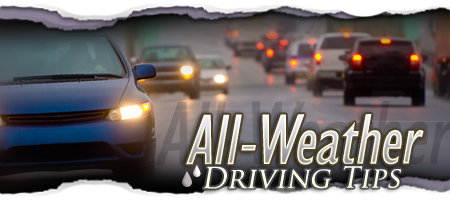|

Snow, Sleet, Rain & More -
Drive Safely In Any Condition
The
best advice for driving in bad winter weather is not to
drive at all, if you can avoid it. Don't go out until the
snow plows and sanding or salt trucks have had a chance
to do their work, and allow yourself extra time to reach
your destination.
If
you must drive in snowy conditions, make sure your car is
prepared, and that you know how to handle road conditions.
It's helpful to practice winter driving techniques in a
snowy, open parking lot so you're familiar with how your
car handles. Consult your owner's manual for tips specific
to your vehicle.
Driving
safely on icy roads...
-
Decrease
your speed and leave yourself plenty of room to stop.
You should allow at least three times more space than
usual between you and the car in front of you.
-
Brake
gently to avoid skidding. If your wheels start to lock
up, ease off the brake.
-
Turn
on your lights to increase your visibility to other motorists
on the road.
-
Keep
your lights and windshield clean.
-
Use
low gears to keep traction, especially on hills.
-
Don't
use cruise control or overdrive on icy roads.
-
Be
especially careful on bridges, overpasses and infrequently
traveled roads, which will freeze first. Even at temperatures
above freezing, wet conditions might cause ice to form
in shady areas or on exposed roadways like bridges.
-
Don't
pass snow plows and sanding/salt trucks. The drivers have
limited visibility, and you're likely to find the road
in front of them worse than the road behind.
-
Don't
assume your vehicle can handle all conditions. Even four-wheel
and front-wheel drive vehicles can encounter trouble on
winter roads.
If
your rear wheels skid...
-
Take
your foot off the accelerator. Steer in the direction
you want the front wheels to go. If your rear wheels are
sliding left, steer left. If they're sliding right, steer
right.
-
If
your rear wheels start sliding the other way as you recover,
ease the steering wheel toward that side. You might have
to steer left and right a few times to get your vehicle
completely under control.
-
If
you have standard brakes, pump them gently.
-
If
you have anti-lock brakes (ABS), do not pump the brakes.
Apply steady pressure to the brakes. You will feel the
brakes pulse – this is normal.
If
you get stuck...
-
Do
not spin your wheels. This will only dig you in deeper.
-
Turn your wheels from side to side a few times.
-
Use
a light touch on the gas, to ease your car out.
-
Use
a shovel to clear snow from the car's wheels, underside.
-
Pour
sand, kitty litter, gravel or salt in the path of the
wheels to help get traction on a diffucult ground surface.
-
Try
rocking the vehicle. (Check your owner's manual first
– it can damage the transmission on some vehicles.) Shift
from forward to reverse, and back again. Each time you're
in gear, give a light touch on the gas until the vehicle
gets going.
If
you become stranded...
-
Do
not leave your car unless you know exactly where you are,
how far it is to possible help, and are certain you will
improve your situation.
-
To
attract attention, light two flares and place one at each
end of the car a safe distance away. Next, hang a brightly colored
cloth from your antenna.
-
If
you are sure the car's exhaust pipe is not blocked, run
the engine and heater for about 10 minutes every hour
or so depending upon the amount of gas in the tank.
-
To
protect yourself from frostbite and hypothermia use the
woolen items and blankets to keep warm.
-
Keep
at least one window open slightly because heavy snow and ice
can cause a car to seal shut.
-
Eat
a hard candy to keep your mouth moist
Sources: National Safety Council, New
York State Department of Motor Vehicles, Washington
State Government Information & Services |